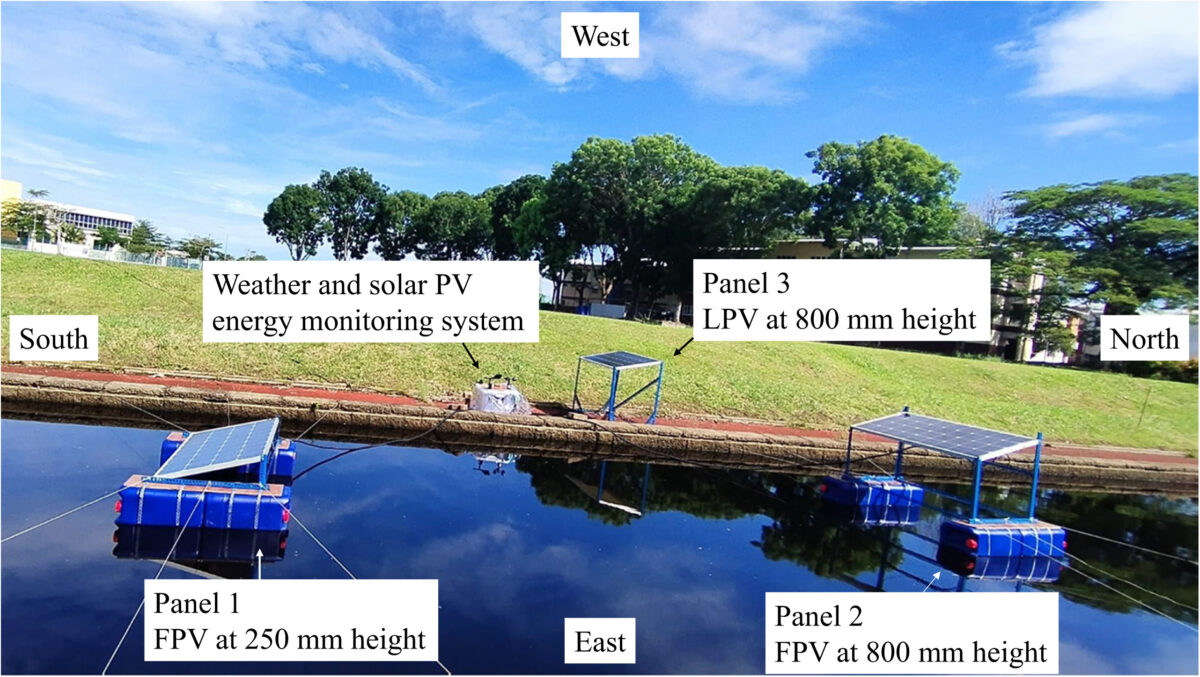Researchers based at Curtin University’s Malaysian campus have compared the thermal behavior of floating PV (FPV) installed at different heights, also benchmarking it against a land-based system.
“We analyse those in a real-world environment,” corresponding author Ramanan C.J. told pv magazine. “This study experimentally validates the outcomes of our previous computational work, and as for the next step, we are working on numerical estimations.”
The study was conducted at Miri, a city in East Malaysia, on a 5-metre-wide water passage. All setups included a 100 W monocrystalline PV module type with an efficiency of 15.5%. Its dimensions were 1,252 × 670 × 30 mm.
Panel 1 was an FPV panel, installed 250 mm above the water, while FPV 2 was installed 800 mm above the water. Panel 3 was installed on land, also 800 mm above ground. The ideal solar PV tilt angle for Malaysia is 15°, and the azimuth was maintained at 0° South for all three systems.

The FPVs were built using high-density polyethylene (HDPE) cans, plywood, steel band wrap, slotted angle bars, nuts, and bolts; while the land PV was constructed using a slotted angle bar. Measurement sensors were connected to a Raspberry Pi computer, with electronics enclosures in a plastic box, and the wires covered by PVC conduit.
Data were collected for a total of six days from 16 to 23 July 2024, with the analysis showing that high-height FPV showed the greatest cooling effect, followed by the identical land PV (LPV) system, and then the low-height FPV.
“As a result, the low-height FPV reached temperatures over 2 C cooler than the LPV system, though this cooling advantage occurred mainly at sunrise when solar radiation was low and unsuitable for effective energy generation,” the academics said. “During the daytime, the high-height FPV provided a cooling benefit 57% of the time, maintaining a temperature range of 0C to 2C lower than the LPV with the same height.”
They also found that the cooling effect made the high-height FPV the most effective system. In terms of power generation, the high-height FPV reached a peak performance improvement of 2.45% over the low-height FPV. It also reached a peak performance improvement of 1.47% over the LPV during the afternoon.
“In contrast, the low-height FPV demonstrated minimal cooling benefits during most of the day, with temperatures primarily ranging from 0C to 1C above the LPV,” the scientists added.
Their findings were presented in “Thermal behavior of floating photovoltaics: A comparison of performance at varying heights and benchmarking against land-based photovoltaics,” published in Applied Energy.
This content is protected by copyright and may not be reused. If you want to cooperate with us and would like to reuse some of our content, please contact: editors@pv-magazine.com.








By submitting this form you agree to pv magazine using your data for the purposes of publishing your comment.
Your personal data will only be disclosed or otherwise transmitted to third parties for the purposes of spam filtering or if this is necessary for technical maintenance of the website. Any other transfer to third parties will not take place unless this is justified on the basis of applicable data protection regulations or if pv magazine is legally obliged to do so.
You may revoke this consent at any time with effect for the future, in which case your personal data will be deleted immediately. Otherwise, your data will be deleted if pv magazine has processed your request or the purpose of data storage is fulfilled.
Further information on data privacy can be found in our Data Protection Policy.